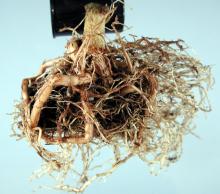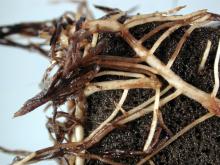See:
Greenhouse Plants, Ornamental - Pythium Seed Rot, Damping-off, and Root Rot
Cause Pythium ultimum, P. aphanidermatum (found more often on roots in the Northeast United States), and other Pythium spp., fungal-like organisms. Problems with particular species may appear at different times of the year since different species have different temperature requirements. The organism may be in roots of new cuttings. It enters roots damaged by high soluble salts, either from over-fertilization or from letting the rooting medium dry out, even for short periods, during propagation. The cultivar Freedom does not need as much fertilizer and could be damaged more easily than other cultivars. Cool, wet soils also favor the disease. Generally more a problem as plants mature.
Cultivars that have some resistance include Autumn Leaves, Luv U Pink, Premium Ice Crystal, Premium Red, Princettia Dark Pink, and Visions of Grandeur.
Symptoms Diseased roots are discolored brown and/or appear water soaked. Fine roots turn mushy and slough off leaving mostly thicker, older roots behind. The root cortex of the smaller roots can often be easily slipped off, thus leaving a white cylinder of vascular tissue behind. Root rot causes lower leaves to yellow, wilt, and roll. Marginal leaf burning may also be one of the first symptoms found. Plants may remain stunted and flower prematurely. Plants also can wilt and die suddenly, especially if soluble salts are high. A cutting rot can also occur where the cutting is brown and has a water-soaked appearance. The callus and any new roots at the base of the cutting also turn brown. Can be confused with Phytophthora or Fusarium root rots.
Cultural control This disease is difficult to control once it has begun. Focus on preventing the disease before it begins by eliminating the pathogen from the production system. Clean growing surfaces, clean water, and handling practices, along with soilless media are all helpful. Water management is critical including avoiding ebb and flood systems if possible.
- Grow the plants at 69°F to 76°F and at a recommended pH range of 5.8 to 6.2
- Plant pathogen-free cuttings. Inspect carefully before planting.
- Use soilless potting mix or steam-treated soil and rooting media. Steam 30 min. at 180°F. Also disinfect any tools and equipment that might be used and contaminate the media.
- Use suppressive growing media such as composted pine, fir, or hardwood bark or Canadian sphagnum peat at the H2 level of decomposition.
- Use new pots, trays, or treat any reused items with a disinfectant, use steam, or solarization techniques (such as with anti-condensation film) to clean them.
- Do not over-fertilize or let plants dry out. Fertilize less as plants mature. Monitor soluble salt concentrations regularly keeping the EC below 2.0 early and 1.2 later.
- Remove and destroy any diseased plants before planting or during the growing cycle. Do not contaminate adjacent pots while removing dead plants.
- Trial different cultivars to see which might be more easily managed in your production facility. Moderately resistant cultivars such as 'Princettia Max White', 'Prestige Red', or 'Luv U Pink' can be integrated with chemical management when only a single drench fungicide application is desired.
Chemical control Use only with cultural controls. Drench pots thoroughly and not through a drip system. Rotate among fungicides with different modes of action. Isolates of the fungus resistant to Group 4 fungicides have been detected in the Northeast United States. Limit the use of any one group during crop production.
- Banol at 2 to 3 fl oz/10 gal water. Group 28 fungicide. 12-hr reentry.
- Banrot 40 WP at 6 to 12 oz/100 gal water. Avoid using granular formulation. Group 1 + 14 fungicide. 12-hr reentry.
- Empress at 1 to 3 fl oz/100 gal water can be used for cuttings or seedlings. Group 11 fungicide. 12-hr reentry.
- Fenstop at 7 to 14 fl oz/50 to 100 gal water. Use 1 to 2 pints/sq ft. For greenhouse use only. Group 11 fungicide. 12-hr reentry.
- Fosphite at 1 to 2 quarts/100 gal water. Do not use copper products within 20 days of treatment and do not use spray adjuvants. Group P7 fungicide. 4-hr reentry.
- Mefenoxam 2 AQ at 0.49 to 0.98 fl oz/100 gal water as a soil drench, see label for media incorporation. Group 4 fungicide. No restrictions on reentry when used as a soil drench or media incorporation.
- MetaStar 2E at 0.5 to 2 fl oz/100 gal water. Group 4 fungicide. No restrictions on reentry when used as a soil drench or media incorporation.
- Monterey Garden Phos at 1 teaspoons/8 gal water as a soil drench. Group P7 fungicide. H
- OxiPhos at 1.3 to 4 quarts/100 gal water as a foliar spray. Group P7 fungicide. 4-hr reentry.
- Proplant at 2 to 3 fl oz/10 gal water. Group 28 fungicide. 12-hr reentry.
- Segway SC at 1.5 to 3 fl oz/100 gal water. Drench rate is based on pot diameter. Group 21 fungicide. 12-hr reentry.
- Subdue MAXX at 0.5 to 1 fl oz/100 gal water. Use 1 pint solution/sq ft. Group 4 fungicide. No restrictions on reentry when used as a soil drench.
- Terrazole 35 WP at 3.5 to 10 oz/100 gal water. Some growers feel the maximum rate should be 4 to 6 oz/100 gal water to avoid root damage. Group 14 fungicide. 12-hr reentry.
- Truban 30 WP at 3 to 10 oz/100 gal water. Some growers feel the maximum rate should be 4 to 6 oz/100 gal water to avoid root damage. Group 14 fungicide. 12-hr reentry.
Some registered products offer only suppression of this disease and thus are not recommended for use. These products include Heritage.
Biological control Use in conjunction with other control tactics such as thorough sanitation.
- Bio-Tam 2.0, Tenet WP, or Obtego (Trichoderma asperellum and T. gamsii) at 0.5 to 1.5 lb/cubic yard of substrate. See label for details and other application methods. No restrictions on reentry when soil incorporated. O
- LALStop G46 WG (Clonostachys rosea [formerly Gliocladium catenulatum] strain J1446) at 0.33 oz/5 gal water. Do not use with other products in the tank.4-hr reentry. O
- PlantShield HC (Trichoderma harzianum Rifai strain T-22) at 3 to 5 oz/100 gal water as a soil drench. 4-hr reentry. O
- RootShield Plus Granules (Trichoderma harzianum Rifai strain T-22 and T. virens strain G-41) at 1 to 3 lb/cubic yard soil mix. Use before symptoms develop. Some greenhouses report it helps. No restrictions on reentry required when soil incorporated. O
References Moorman, G.W. 1986. Increased plant mortality caused by pythium root rot of poinsettia associated with high fertilization rates. Plant Disease 70:160-162.
Lookabaugh, E. C., Kerns, J. P. and Shew, B. B., 2021. Evaluating Fungicide Selections to Manage Pythium Root Rot on Poinsettia Cultivars with Varying Levels of Partial Resistance. Plant Disease, 105:1640-1647.




